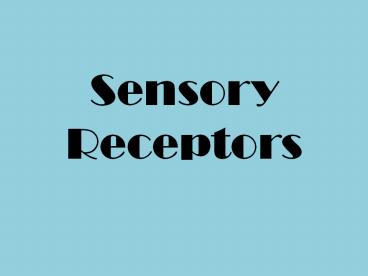Sensory%20Receptors - PowerPoint PPT Presentation
Title:
Sensory%20Receptors
Description:
Sensory Receptors Receptors There are millions of receptors all over the body. Receptors may be simple naked nerve endings, encapsulated nerve endings or complex ... – PowerPoint PPT presentation
Number of Views:225
Avg rating:3.0/5.0
Title: Sensory%20Receptors
1
Sensory Receptors
2
Receptors
- There are millions of receptors all over the
body. Receptors may be simple naked nerve
endings, encapsulated nerve endings or complex
structures. - Receptors detect stimuli (internal or external)
convert them to nerve impulses
3
The sensory receptors
- Each sensory system has three component parts
1)Sensory receptors which are the branched
endings of sensory neurons or specialized cells
adjacent to them that detect specific stimuli.
2)Nerve pathways lead to the brain. 3)Brain
regions process the information into a sensation
later, perhaps, a perception (understanding) of
the sensation will be made.
4
How does a sensory receptor work?
- Some sensory receptors are activated when they
are bent, squished, or disturbed in some way. - Others are activated by chemicals.
- Others by temperature.
- And others by light.
- Whatever the outside world influence is, we can
call it a stimulus for the receptor
5
- Whatever the appropriate stimulus is, that will
cause a depolarization to occur in the sensory
receptor cell - The depolarization within the sensory dendrite
itself (due to the stimulus) is called a receptor
potential - When the dendrite is deformed, its membrane
stretches, and ions can flow through the
stretch-gated channels. If this occurs enough,
there will be enough of a receptor potential to
trigger an action potential.
6
In summary
7
Sense of touch
- Touch may be considered one of five human senses
however, when a person touches something or
somebody this gives rise to various feelings the
perception of pressure (hence shape, softness,
texture, vibration, etc.), relative temperature
and sometimes pain. - The term "touch" is usually replaced with somatic
senses, to better reflect the variety of
mechanisms involved
8
- Free nerve endings are simply branched endings of
sensory neurons in the skin that function as
mechanoreceptors, thermoreceptors, and pain
receptors. - Meissner corpuscles adapt slowly to vibrations of
low frequencies. - The bulb of Krause is a thermoreceptor that is
sensitive to temperatures below 20 degrees C. - Ruffini endings are sensitive to steady touching
and pressure, and to temperatures above 45
degrees C. - Pacinian corpuscles are located both in the
dermis and near joints they are able to detect
rapid pressure changes associated with touch and
vibrations.
9
Sense of vision
- Vision requires a complex system of
photoreceptors and neural program in the brain
that can interpret the patterns of action
potentials - All photoreceptors incorporate pigment molecules
that can absorb photon energy, which can be
converted into excitation energy in sensory
neurons. - The photoreceptors are located in the retina
10
(No Transcript)
11
Results
- Normal Color Vision A 29, B 45, C --, D
26 - Red-Green Color-Blind A 70, B --, C 5,
D -- - Red Color-blind A 70, B --, C 5, D 6
- Green Color-Blind A 70, B --, C 5, D 2
12
Sense of hearing
- Hearing is the perception of sounds, which are
traveling vibrations of mechanical energy
13
Hearing test
- Normal human hearing ranges from 20 Hz to 20 kHz
- A gradual decline with age is considered normal
14
- The middle ear contains small bones with amplify
the sounds - before transmittal to the inner ear.
- The external ear in mammals has a pinna for
collecting the - sounds.
- In the cochlea of the inner ear, acoustical
receptors in the - form of hair cells respond to pressure waves
transmitted - through the surrounding fluid.
- Impulses are sent along the auditory nerve to the
brain for interpretation. - The hair cells of the human ear can be
permanently damaged by prolonged exposure to
intense sounds
15
Sense of smell
- Olfactory receptors are responsible for our sense
of smell. - They respond to a variety of odour molecules
- Humans have about 5 million olfactory receptor
neurons - Olfactory receptor neurons reside on the
olfactory epithelium in the nasal cavity
16
Sense of taste
- Taste receptors enable animals to distinguish
nutritious from noxious substances. Receptors
of some animals are located on antennae, legs,
tentacles, or fins. In humans, taste receptors
are often components of taste buds distributed
mostly on the tongue.
17
Questions
- What are receptors?
- What are the three components of the sensory
system? - How many senses do we humans have? Five or more?
Name them - How does a sensory receptor work? (Brief
description) - What is the name of the receptor involved in your
sense of smell? - Where are the sense of taste receptors located in
the human body?































